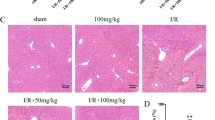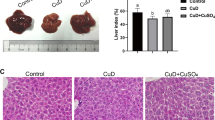Abstract
Copper deficiency can cause a host of major cardiovascular complications including an augmented inflammatory response through effects on both neutrophils and the microvascular endothelium. In the present study, we evaluated the effect of marginal copper deficiency on the neutrophilic response to hepatic ischemia/reperfusion injury, a condition that induces an inflammatory response. Male weanling Sprague–Dawley rats were fed purified diets which were either copper-adequate (6.3 mg/kg) or copper-marginal (1.62 mg/kg) for 4 weeks prior to undergoing 90 min of partial hepatic ischemia followed by 8 h of reperfusion. Liver injury was assessed by serum levels of alanine aminotransferase and by liver histology. Liver neutrophil accumulation was determined by tissue myeloperoxidase content. There was no significant difference in liver injury between copper-adequate and copper-marginal rats. However, liver neutrophil accumulation was significantly increased in copper-marginal rats. These findings were confirmed histologically. Liver expression of the adhesion molecule, intercellular adhesion molecule-1 (ICAM-1), was increased in copper-marginal rats compared to copper-adequate rats. The results suggest that neutrophil accumulation is increased through enhanced ICAM-1 expression in liver of copper-marginal rats after ischemia/reperfusion, but that this does not result in increased liver injury.




Similar content being viewed by others
References
Bertinato J, L'Abbe MR (2004) Maintaining copper homeostasis: regulation of copper-trafficking proteins in response to copper deficiency or overload. J Nutr Biochem 15:316–322
Sarricolea ML, Villa-Elizaga I, Lopez J (1993) Respiratory distress syndrome in copper deficiency: an experimental model developed in rats. Biol Neonate 63:14–25
Chen CC, Takeshima F, Miyazaki T et al (2007) Clinicopathological analysis of hematological disorders in tube-fed patients with copper deficiency. Intern Med 46:839–844
Jayakumar S, Micallef-Eynaud PD, Lyon TD et al (2005) Acquired copper deficiency following prolonged jejunostomy feeds. Ann Clin Biochem 42:227–231
Sriram K, O'Gara JA, Strunk JR et al (1986) Neutropenia due to copper deficiency in total parenteral nutrition. JPEN J Parenter Enteral Nutr 10:530–532
Prodan CI, Holland NR, Wisdom PJ et al (2002) CNS demyelination associated with copper deficiency and hyperzincemia. Neurology 59:1453–1456
Griffith DP, Liff DA, Ziegler TR et al (2009) Acquired copper deficiency: a potentially serious and preventable complication following gastric bypass surgery. Obesity 17:827–831
Steinbrook R (2004) Surgery for severe obesity. N Engl J Med 350:1075–1079
Lentsch AB, Kato A, Saari JT et al (2001) Augmented metalloproteinase activity and acute lung injury in copper-deficient rats. Am J Physiol Lung Cell Mol Physiol 281:L387–L393
Gordon SA, Lominadze D, Saari JT et al (2005) Impaired deformability of copper-deficient neutrophils. Exp Biol Med 230:543–548
Lominadze D, Saari JT, Percival SS et al (2004) Proinflammatory effects of copper deficiency on neutrophils and lung endothelial cells. Immunol Cell Biol 82:231–238
Schuschke DA, Percival SS, Lominadze D et al (2002) Tissue-specific ICAM-1 expression and neutrophil transmigration in the copper-deficient rat. Inflammation 26:297–303
Saari JT (2000) Copper deficiency and cardiovascular disease: role of peroxidation, glycation, and nitration. Can J Physiol Pharmacol 78:848–855
Paynter DI, Moir RJ, Underwood EJ (1979) Changes in activity of the Cu-Zn superoxide dismutase enzyme in tissues of the rat with changes in dietary copper. J Nutr 109:1570–1576
Lentsch AB, Kato A, Yoshidome H et al (2000) Inflammatory mechanisms and therapeutic strategies for warm hepatic ischemia/reperfusion injury. Hepatology 32:169–173
Jaeschke H, Farhood A (1991) Neutrophil and Kupffer cell-induced oxidant stress and ischemia-reperfusion injury in rat liver. Am J Physiol 260:G355–G362
Jaeschke H (1991) Reactive oxygen and ischemia/reperfusion injury of the liver. Chem Biol Interact 79:115–136
Suzuki S, Toledo-Pereyra LH (1994) Interleukin 1 and tumor necrosis factor production as the initial stimulants of liver ischemia and reperfusion injury. J Surg Res 57:253–258
Wanner GA, Ertel W, Muller P et al (1996) Liver ischemia and reperfusion induces a systemic inflammatory response through Kupffer cell activation. Shock 5:34–40
Lentsch AB, Yoshidome H, Kato A et al (1999) Requirement for interleukin-12 in the pathogenesis of warm hepatic ischemia/reperfusion injury in mice. Hepatology 30:1448–1453
Colletti LM, Remick DG, Burtch GD et al (1990) Role of tumor necrosis factor-alpha in the pathophysiologic alterations after hepatic ischemia/reperfusion injury in the rat. J Clin Invest 85:1936–1943
Clarke CN, Kuboki S, Tevar A et al (2009) CXC chemokines play a critical role in liver injury, recovery, and regeneration. Am J Surg 198:415–419
Lentsch AB, Yoshidome H, Cheadle WG et al (1998) Chemokine involvement in hepatic ischemia/reperfusion injury in mice: roles for macrophage inflammatory protein-2 and KC. Hepatology 27:1172–1177
Okaya T, Lentsch AB (2003) Cytokine cascades and the hepatic inflammatory response to ischemia and reperfusion. J Invest Surg 16:141–147
Jaeschke H (2006) Mechanisms of liver injury. II. Mechanisms of neutrophil-induced liver cell injury during hepatic ischemia-reperfusion and other acute inflammatory conditions. Am J Physiol Gastrointest Liver Physiol 290:G1083–G1088
Schierwagen C, Bylund-Fellenius AC, Lundberg C (1990) Improved method for quantification of tissue PMN accumulation measured by myeloperoxidase activity. J Pharmacol Meth 23:179–186
Farhood A, McGuire GM, Manning AM et al (1995) Intercellular adhesion molecule 1 (ICAM-1) expression and its role in neutrophil-induced ischemia-reperfusion injury in rat liver. J Leukoc Biol 57:368–374
Wildman RF, Hopkins R, Failla ML et al (1995) Marginal copper-restricted diets produce altered cardiac ultrastructure in the rat. Proc Soc Exp Med 210:43–49
Li Y, Wang L, Schuschke DA et al (2005) Marginal dietary copper restriction induces cardiomyopathy in rats. J Nutr 135:2130–2136
Schuschke LA, Saari JT, Miller FN et al (1995) Hemostatic mechanisms in marginally copper-deficient rats. J Lab Clin Med 125:748–753
Schuschke DA, Percival SS, Saari JT et al (1999) Relationship between dietary copper concentration and vasodilation in the microcirculation of rats. Biofactors 10:321–327
Schuschke DA, Adeagbo ASO, Patibandla PK et al (2009) Cyclooxygenase-2 is upregulated in copper-deficient rats. Inflammation 32:333–339
Falcone JC, Saari JT, Kang YJ et al (2005) Vasoreactivity in an adult rat model of marginal copper deficiency. Nutr Res 25:177–186
Jaeschke H, Farhood A, Smith CW (1990) Neutrophils contribute to ischemia/reperfusion injury in rat liver in vivo. FASEB J 4:3355–3359
Ramaiah SK, Jaeschke H (2007) Role of neutrophils in the pathogenesis of acute inflammatory liver injury. Toxicol Pathol 35:757–766
Karimbakas J, Langkamp-Henken B, Percival SS (1998) Arrested maturation of granulocytes in copper deficient mice. J Nutr 128:1855–1860
Babu U, Failla ML (1990) Copper status and function of neutrophils are reversibly depressed in marginally and severely copper-deficient rats. J Nutr 120:1700–1709
Babu U, Failla ML (1990) Respiratory burst and candidacidal activity of peritoneal macrophages are impaired in copper-deficient rats. J Nutr 120:1692–1699
Allen CB, Saari JT (1993) Isolated hearts from copper-deficient rats exhibit improved postischemic contractile performance. J Nutr 123:1794–1800
Acknowledgements
We thank Sharon Gordon for her expert technical assistance. This study was supported by National Institute of Diabetes and Digestive and Kidney Diseases Grant DK-55030. The US Department of Agriculture, Agricultural Research Service, Northern Plains Area, is an equal opportunity/affirmative action employer, and all agency services are available without discrimination.
Author information
Authors and Affiliations
Corresponding author
Rights and permissions
About this article
Cite this article
Sakai, N., Shin, T., Schuster, R. et al. Marginal Copper Deficiency Increases Liver Neutrophil Accumulation After Ischemia/Reperfusion in Rats. Biol Trace Elem Res 142, 47–54 (2011). https://doi.org/10.1007/s12011-010-8743-9
Received:
Accepted:
Published:
Issue Date:
DOI: https://doi.org/10.1007/s12011-010-8743-9




